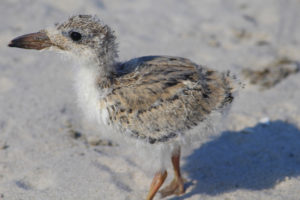For me, any day spent on the beach rather than in my office is a good day. Add in great people and fun, active work aimed at protecting rare shorebirds, and that beach day quickly upgrades to great. Throw in the chance to hold fluffy, adorable chicks, and, well…we’re talking epic.

black skimmer (Rynchops niger) chick
Last week, I had the opportunity to join staff members from the New York State Department of Environmental Conservation (NYSDEC), the New York Audubon Society, the U.S. Fish and Wildlife Service and the Town of Hempstead on an annual outing to Nickerson Beach in Nassau County, Long Island to band a colony of black skimmer (Rynchops niger) chicks.
As their name suggests, black skimmers literally skim the surface of the water to feed. Their lower jaw slips beneath the water, and when it touches a fish, the upper bill snaps to catch it. It’s a cool bird to watch…but the chance to see one is sometimes difficult.
In wintertime, black skimmers are primarily located on southern coasts, from the Carolinas to Central America. But in the spring, they migrate north to breed, and they like to nest on sandy beaches and marsh islands. The same kind of sandy beaches that we humans like to vacation on. So it is not surprising that the black skimmer is now endangered in New Jersey and of special concern in New York.
Because of my involvement in dune nourishment projects, I do a lot of monitoring of shorebirds along New Jersey beaches. This summer alone, I have probably spent 10 hours or more each week taking note of bird life along these beaches, but not once this summer on the New Jersey Beaches have I seen a black skimmer.
So it was amazing, last week, to walk out onto Nickerson Beach and suddenly see a colony of 600 breeding pairs. According to my colleagues on the banding trip, this population is stable. Once my sense of awe subsided enough for me to actually move, the fun really began.
Apparently, last year, it took three days to chase and catch only 25 black skimmer chicks to band. But this year, Jason Smith from NYSDEC developed a new way to corral the chicks, who cannot yet fly, using a temporary fence-like structure and we were able to band 89 of them within two hours. This method not only lessened our stress, but that of the chicks and adults. Each chick was banded with a USFWS metal band on its left leg, and those with big enough legs received a bright yellow field-readable ID band on their right leg.
Banding these birds is important because it helps us find out where the skimmers are going during the rest of the year and see how many chicks return as adults to breed in their natal colony.
It is one thing to look for, read about, and then actually see a species that is endangered (in New Jersey). It is quite another to hold one in your hand, where its vulnerability is, literally, tangible. The chicks felt so fragile. When I held them in order to band them, all I could feel was the beating of their hearts. That is the pulse of a day well spent.
Further Reading
Meet Assistant Construction Project Team Leader Bryan SullivanMeet Conservation Biologist Nolan Schillerstrom
Get to know Allyson Gibson, Biohabitats Extern
Get to Know Graphic Designer Joey Marshall
Evolution: A New Leadership Team for Biohabitats
More From This Author
Tomorrow’s eco-professionals bring much needed hope – and actionThoughts on Eco-Voluntourism
Learning from Hurricane Sandy
An Oasis in the Most Unlikely Place
Pandemic Pause

